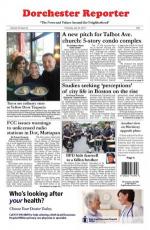March 7, 2018
There has been some social media chatter recently about another news organization’s analysis of Boston Police Department crime data that drew its conclusions from a misapplication of demographic information and an overgeneralization of neighborhood boundaries.
The Reporter wrote a year-in-review story on crime, using the same data, and the local reaction to rising homicide rates, which can be read here, but, first, a few things to keep in mind about the other organization’s methodological shortfalls.
The analysis, published by the online-only Dorchester Post, asserted that in 2017 Dorchester had a lower crime rate than most other areas of the city. Judging from the crime data the two reporters who wrote the article cited, they deemed police district C-11 as comprising all of Dorchester, so their analysis, projecting District C-11 and its 10 percent drop in crime as representative of the entirety of Dorchester, concludes that all of Dorchester had 2,034 instances of part one crime in 2017.
But Dorchester is larger than a single police district.
While District C-11 falls neatly within the established bounds of the neighborhood, Dorchester also sprawls into significant portions of C-6 (to the north), B-2 (to the northwest), and B-3 (to the south). The following sections of Dorchester fall outside the C-11 district: villages like Columbia Point and the Polish Triangle; the Blue Hill Avenue corridor; parts of the Dudley Triangle and Uphams Corner; Grove Hall; parts of Codman Square and Codman Hill alongside Mattapan’s northern border; and streets around the Franklin Park and Franklin Field neighborhoods.
These parts of Dorchester should be included in any analysis of the entire neighborhood, and any survey should note the several police districts by name when comparing and contrasting them in the service of an analysis.
In an attempt to break crime down to a per 1,000 resident-rate, the Post reporters used Boston Planning and Development Agency (BPDA) population data for the entire neighborhood and set the numbers against those from the C-11 alone, leading to the implication that crime that occurs in C-11 is all of the crime in overall Dorchester. The reporters did not add in the incidences of crime that occurred outside of C-11 but still within the city’s classification of the boundaries of Dorchester. With that omission, they calculated an exceedingly low crime rate by dividing the total number of C-11 district incidents in 2017 by 124, based on the estimated population of Dorchester (about 124,00), and contrasting that rate to similarly misaligned crime rates for the other neighborhoods and districts in the city.
As for the accounting of crimes by category, part one crime – homicides, rapes, robberies, aggravated assaults, burglaries, larcenies, and automobile thefts – is down in the city as a whole and in many of the Dorchester districts. However, the jumps in murders continue to be disproportionately focused in Dorchester, Mattapan, and Roxbury, all of which saw spikes in homicides, which make up a minuscule percentage of overall part one crime.
Larcenies, which account for about 58 percent of all part one crime, occur far more frequently in districts like the South End’s D-4 and Downtown’s A-1, each of which saw two homicides in 2017. As a result, smaller proportionate downward swings in larcenies can completely overshadow increases in more serious crimes.
Homicides account for 0.3 percent of overall part one crime in the city, and areas B and C together – including Dorchester, South Boston, Roxbury, and Mattapan – accounted for 48 of the year’s 56 homicides by Christmas 2017. This is a significant discrepancy in crime by neighborhood.
The Dorchester Post analysis suffers from the same homicide rate calculation problems as it does with crime as a whole; it uses mismatched boundaries for districts and neighborhoods, relying on the broad Boston Police classification of a primarily “Dorchester” or “Mattapan” police district as comparable with the city’s official neighborhood boundaries. The assessment of South Boston jumping by 600 percent in homicides – from 1 to 6 – ignores the fact that three of those C-6 homicides took place in Dorchester.
Dorchester, Mattapan, and Roxbury have long been shackled to reputations as unsafe neighborhoods, but countering that narrative by miscalculating crime rates and attributing any flaws in the analysis to the use of broad boundary and population descriptions is ultimately a disservice to the neighborhoods themselves. Violence is distributed unevenly in Boston, and getting to an understanding of the relative crime rates by neighborhood requires a more rigorous statistical analysis than this piece provided.
Jennifer Smith can be reached at jennifer.smith@dotnews.com, or follow her on Twitter at @JennDotSmith
Topics:



